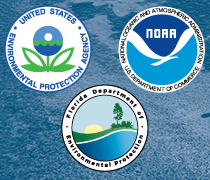
Seagrass Monitoring Project (WQMP)
The general objective of seagrass monitoring in the Florida Keys National Marine Sanctuary (FKNMS) is to measure the status and trends of seagrass communities to evaluate progress toward protecting and restoring the living marine resources of the Sanctuary. The scope and depth of this monitoring effort are without precedent or peer for seagrass ecosystems throughout the world. Specific objectives are: 1) To provide data needed to make unbiased, statistically rigorous statements about the status and temporal trends of seagrass communities in the Sanctuary as a whole and within defined strata; 2) To help define reference conditions in order to develop resource-based water quality standards; and 3) To provide a framework for testing hypothesized pollutant fate/effect relationships through process-oriented research and monitoring. In order to meet these objectives, we have developed these goals for the project:
- Define the present distribution of seagrasses within the FKNMS
- Provide high-quality, quantitative data on the status of the seagrasses within the FKNMS
- Quantify the importance of seagrass primary production in the FKNMS
- Define the baseline conditions for the seagrass communities
- Determine relationships between water quality and seagrass status
- Detect trends in the distribution and status of the seagrass communities
To reach these goals, four kinds of data are being collected in seagrass beds in the FKNMS:
- Distribution and abundance of seagrasses using rapid assessment Braun-Blanquet surveys
- Demographics of the seagrass communities using leaf-scar counting and population demographics techniques
- Seagrass productivity of the dominant species of seagrass in the FKNMS (Thalassia testudinum) using the leaf-mark and harvest method
- Seagrass nutrient availability using tissue concentration assays
These data are being collected at three different types of sites within the FKNMS:
- Level 1 Stations: Sampled quarterly for seagrass abundance, demographics, productivity and nutrient availability. These stations are all co-located with the water quality monitoring project's stations
- Level 2 Stations: Randomly selected locations within the FKNMS, sampled annually for seagrass abundance, demographics and nutrient availability. Each year, new locations for Level 2 stations are chosen.
- Level 3 Stations: Randomly selected locations within the FKNMS, sampled annually for seagrass abundance. Each year, new locations for Level 3 stations are chosen.
We are assessing both inter-annual and intra-annual trends in seagrass communities. The mix of site types is intended to monitor trends through quarterly sampling at a few permanent locations (Level 1 sites) and to annually characterize the broader seagrass population through less intensive, one-time sampling at more locations (Level 2 and 3 sites).
For the latest seagrass monitoring data, please visit the FIU Seagrass Ecosystems Research Lab.

